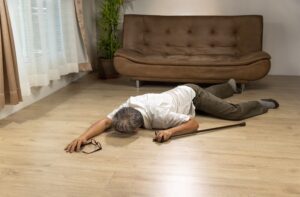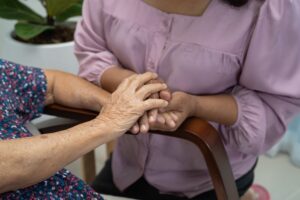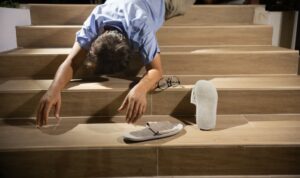My Dad Fell in a Nursing Home, Is It Abuse?
Nursing Home AbuseA family member may fall in a nursing home due to neglect, negligence, or reckless behavior. If you believe that a nursing home caused a fall that led to medical injuries or other losses, seek the help of a nursing home abuse attorney.
The specifics of your case ultimately determine if you have a case for your parent and what legal strategy is best suited for your long-term outcome.
Nursing Home Falls Are Common and Never Okay
 Nursing home falls can occur for many reasons. Some residents slip and fall on a wet floor or carpet that was not pinned down properly. Some residents might fall because staff refuses to provide the necessary assistance or supervision residents need to move or use the restroom.
Nursing home falls can occur for many reasons. Some residents slip and fall on a wet floor or carpet that was not pinned down properly. Some residents might fall because staff refuses to provide the necessary assistance or supervision residents need to move or use the restroom.
However, sometimes, these types of injuries are unrelated to negligence, and they are simply accidents despite the nursing home’s best efforts.
Another concern is how a nursing home responds to a fall. When someone falls, regardless of the reason, the facility should respond with proper and prompt medical attention.
When a nursing home ignores a resident’s medical needs following a fall, it can constitute negligence or abuse, even if the fall itself was an accident.
Is a Nursing Home Responsible for a Fall?
There are numerous instances where a resident at a nursing home falls in a preventable situation.
Every instance of someone falling should receive a comprehensive and complete investigation and understanding of what happened, why it occurred, and the actions taken afterward. This then allows for a better understanding of who is at fault.
A nursing home has a legal duty to provide a safe environment for residents. They also must provide care to prevent falls when there is a heightened risk of a resident falling, such as when it is known that the individual experiences dizzy spells or has weak muscles in their legs.
In situations where you can show the fall was preventable or occurred due to negligence, the nursing home is likely responsible for what occurred. Nursing homes can be liable for failing to prevent a resident from falling.
The key here is proving they could have prevented it or should have known the risk was present but failed to minimize it. Most states have laws to govern the safety patients should receive in a nursing home and require that facilities maintain the highest level of protection for anyone living there.
Individuals in nursing homes should never consider falls an expected or acceptable risk. Most facilities have specific fall prevention methods and training to reduce this risk as much as possible. As noted, though, it does not always happen.
What to Do If Your Parent Falls in a Nursing Home
If your family member fell into a nursing home, no matter what they say, learn more. Residents often dismiss the incident as “it was no big deal” or “I am fine.”
Yet, that does not mean that it was okay. If falls occur once and go unaddressed, they may increase the likelihood of another, worse fall.
Discuss the incident with your family member
 Have a frank conversation with your family.
Have a frank conversation with your family.
- When did it happen?
- Who was around when it happened?
- What did you do before that?
- What happened when you fell?
- How did you fall?
- What hurts?
The more information available, the better you can piece together what occurred. For example, if your parent says, “My foot got caught in the blanket, and I tripped,” ask for more information. Did this happen because no one responded when they called or assisted them while standing despite a known need? This can constitute neglect.
Discuss what happened with staff
Though you should receive a phone call if you are the primary care provider, remember that this may not happen. As a result, if your family member says they fell or you find out in any other way, take action to meet with those present.
This should include:
- Nurses on staff at the time
- Aides on staff at the time
- Any maintenance or supportive staff present
- Anyone who provided medical help to the person
- Anyone who helped them to get up or found them on the ground
Ask questions about what happened and why. Aim for a non-accusatory tone so that you can get honest answers. Avoid bringing up any lawsuit. You just need information. Then, take action to report what occurred if the main nurse did not contact you.
You may also request help from the ombudsman, who should work to support the resident specifically. This person represents the victim. However, the law limits what they can do.
Turn to an attorney
Contact a nursing home abuse attorney. Rather than waiting for an ombudsman or a nursing home doctor to intervene, take action yourself. You want a third party who is not supporting the nursing home in any way to advocate for your family member.
What Caused the Fall?
The most important detail to understand is the cause of the fall. If your dad fell without warning due to a sudden medical issue, then this may not indicate abuse. However, many times, a person who falls in a nursing home does so because of some form of negligence.
The most common reasons for this include:
- Beds that do not have the proper setting, especially being too high
- Wheelchairs fail, or the wheels break on them
- Clutter or debris causes them to trip
- Wet or slippery floors
- Defective equipment
- Unstable furniture
- Tripping over carpeting or rugs
- Clothing that is not on properly
- Poor lighting
- Uneven floors
Because of these risks, most nursing homes have specific rules about keeping residents safe. If they do not clean up the floor after a spill, someone fails to remove trash from the room, and a person falls due to the clutter on the floor, they are likely responsible.
Nursing Homes Should Have Fall Prevention Strategies in Place
Nursing homes should ensure residents’ safety by implementing well-documented and comprehensive fall prevention strategies. Local health departments or the state’s Medicaid office may implement some of these strategies.
Fall prevention strategies are critical to creating a safe living space for those who are older or at risk.
Fall prevention is not an optional task. It is everyone’s job within a nursing home. Numerous strategies may help to reduce the risk of a person falling. Some examples of this include:
Risk assessments
A risk assessment occurs when a resident comes to live at the nursing home. It is a way for nurses and other staff to better understand how likely a person is to fall. This may include understanding any health problems, muscle issues, cognition concerns, or other risks that make a person at risk for falling.
Incontinence care
A common reason residents fall is needing to use the bathroom. It becomes much harder to do this as a person ages, even though most can also go.
Nursing homes must find the best way to minimize falls if a person is likely to struggle in this way. This may include using catheters, adult diapers, or other products to reduce the need to get up.
Medication management
Medication may ensure the health of a resident but not without side effects like instability and dizziness. Pain medications may reduce pain, but they also make it more likely for someone to fall.
Physical activity
A nursing home should provide a high quality of life. However, not all residents can get up and move around freely. Understanding the person’s physical limits is critical, and monitoring for changes becomes necessary.
At the same time, exercise and movement can improve coordination and muscle strength, making a person less likely to fall. Deconditioned patients are at a very high risk of falling.
Modifications in the nursing home
The nursing home itself must be safe. This means that nothing should cause a person to trip. At the same time, supportive tools should include walk-in bathtubs, bed rails, and grab bars. It may also mean providing proper lighting and even floors.
Personal alarms
Many states have limitations on using restraints in nursing homes. Strapping a person to a bed, for example, can be a sign of abuse. However, those with a fall risk may need personal alarms that help nurses know that the person got up when they were not supposed to do so.
Nursing homes should place call buttons within reach. Wearable devices should call for immediate help when needed. Bed alarms may offer support to nurses in monitoring for risks.
Disease management
Disease management focuses on minimizing side effects and monitoring for changes in a person because of their health complications. A person with heart disease, diabetes, arthritis, or other medical concerns may have a higher risk of falling. Consider and plan all the care a person needs accordingly.
Support
A person with a limitation can stand or walk independently and needs help. Most of the time, during a risk assessment, staff will determine how much help a person needs when standing, transferring, or walking.
A person then assumes responsibility for that task. Larger residents may need two people to help with support.
Developing a Culture of Safety
 Another strategy nursing homes have available to them to potentially minimize the risk of a person falling is the development of a culture of safety. That means that ongoing education and training can create a safe nursing home.
Another strategy nursing homes have available to them to potentially minimize the risk of a person falling is the development of a culture of safety. That means that ongoing education and training can create a safe nursing home.
This includes:
- Implementing fall prevention programs
- Hosting training sessions to help support patients
- Encouraging a safety-first mentality in all employees
- Working to reduce injuries
- Identifying risks consistently
- A no-blame/no-shame atmosphere encourages employees to document concerns before they lead to a patient falling
This culture of safety enables every person within the nursing home at any level of patient care and support to understand the importance of preventing falls. They should always make preventing falls a priority.
Know the Risks of a Fall
The consequences of a person in a nursing home falling include:
- Traumatic brain injuries
- Broken bones
- Bruises
- Lacerations
- Soft tissue injuries
- Spinal cord trauma
This leads to additional risks, including a fear of falling, which may limit the resident’s desire to remain social. As a result, they may withdraw from social activities and interactions, leading to feelings of isolation and loneliness. This can further exacerbate their emotional well-being and overall quality of life.
Moreover, there’s a higher likelihood of functional decline and decreased independence without proper support and assistance to prevent further falls.
In a nursing home setting, recognizing that every resident is potentially at risk of falling is crucial. However, certain individuals, such as older adults, those with frail health, individuals on medications, or those recovering from injuries, are particularly vulnerable.
Therefore, implement a comprehensive fall prevention strategy tailored to each resident’s needs. Failure to do so can have severe consequences, potentially risking their lives.
As such, nursing homes must prioritize the safety and well-being of all residents by proactively addressing fall risks and implementing appropriate preventive measures.
Call a Nursing Home Abuse Attorney Today
If this happens to your family member, taking immediate action is crucial.
Contacting a personal injury attorney will aid your understanding of your legal rights in this situation. They can guide you through seeking justice and holding the responsible parties accountable.
Don’t hesitate to take action to ensure the safety and well-being of your loved one.
Nathan Hughey, an attorney and fourth-generation South Carolinian, founded Hughey Law Firm in 2007. Before that, he spent five years defending nursing homes and insurance companies. Leveraging his experience, he now advocates for those injured or wronged by such entities, securing over $290 million in verdicts and settlements.
